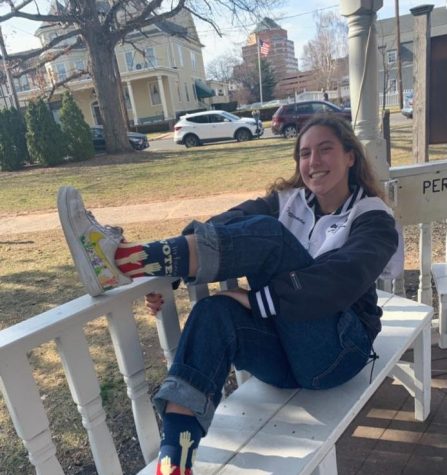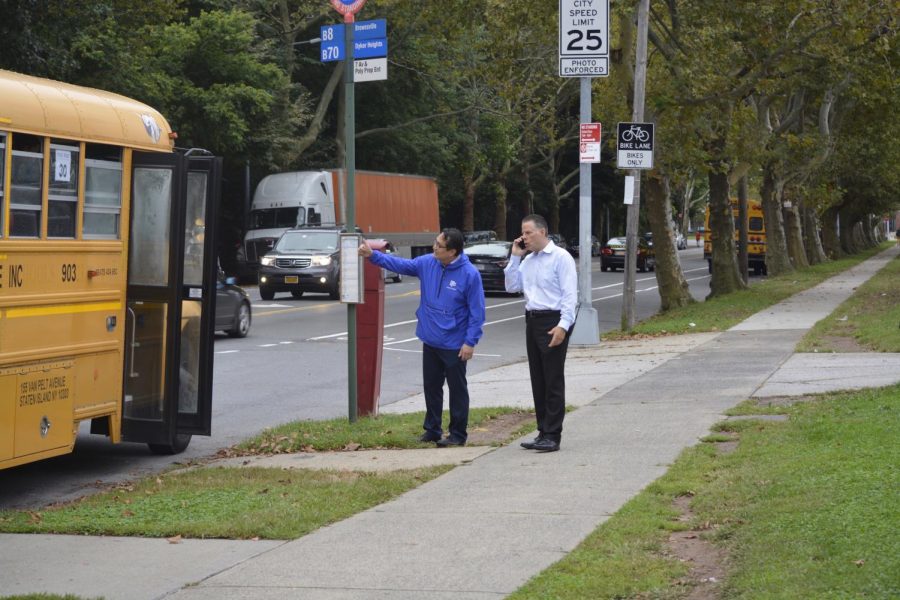Administration Carries Out Bus Overhaul
Changes to create more inclusive bus routes leave some students frustrated.
More News to Read
Chief Operating Officer Hung Bui and Director of Safety and Security Vincent Rutuelo meet buses as they arrive at school. Operations is still working out the kinks of the new system implemented at the start of the year.
The beginning of the school year brought an overhaul to the Poly bus system, with the goal of making the buses less crowded and more punctual, as well as offering coverage for more students in the outer boroughs. However, while these adjustments have helped many students, others are frustrated with changes that make their commute less convenient and longer in duration.
In an email dated September 18th, Associate Head of School and Chief Operating Officer Hung Bui said, that before the bus changes, “only 83.0% of Middle and Upper School students had access to a Poly bus stop (within 500 meters) in the past year.” Thus, when Bui was hired last year, he worked to change that discrepancy. In the same email, he wrote that as a result of the changes, “Poly’s bus system now encompasses 108 zip codes across the city, and more importantly, is accessible to greater than 96% of our Middle and Upper School students.” In addition, four more routes have been added to better serve the community as a whole. Bui said he is “proud that the Poly bus system is as accessible and inclusive as it has ever been. With the addition of four new buses to the Dyker Heights campus, our bus routes travel through all 5 boroughs of New York City.”
The previous imbalance in bus access disproportionately affected students who live further from Poly. The changes implemented this year mean that some route times have changed significantly from the last year.
Bui said, “Creating bus routes for hundreds of Poly families across the five boroughs is an extraordinarily complex task. Students bus ride times vary on three major variables: distance from school, bus capacity, and traffic. Some of our buses travel a much further distance to reach our students. There some routes that have fewer stops because they are able to pick up a large number of students. After two or three stops, the bus reaches capacity and can head directly to campus. Other routes are longer because the student addresses are relatively more spread out.”
Some members of the school community are very appreciative of this attempt at creating equity for all Poly students who write the bus. Senior Leung Wai Liu said, “Sure, people in Manhattan and Brooklyn may have less accommodating rides than previous years, but the greater coverage benefits the Queens and Bronx students by actually having buses to those destinations. I went from having a stressful two hour commute that included three different trains every day to an only one hour and 15 minute commute in a comfortable van.”
Additionally, they added bus I.D. cards in order to increase the safety of the buses. This way, only Poly students and faculty are able to board the bus. It also ensures that the administration will know how many students are on each bus, to prevent overcrowding.
However, while these changes were well-intentioned and have had positive consequences for some, many students are angered by the adjustments. The change in morning pick-up times has been the most controversial. While some students were fortunate and are now being picked up later than last year, allowing for a couple of precious extra minutes of sleep, other students did not have such luck.
“My bus now comes 30 minutes earlier, meaning I get even less sleep than I was getting last year,” said Victor Levy, a sophomore on an Upper West Side bus. Along with the new morning pickup times, students have complained that the afternoon buses are experiencing issues, as well. Some students describe waiting for up to a half hour after the scheduled bus time.
Additionally, Queens students have had to adjust to late buses that take them to transportation hubs rather than home. Some students from Queens that are involved in extracurriculars feel forced to either skip their after-school commitments or take public transportation to get home, should they choose to stay after the 4:00 p.m. departure time.
“How am I going to be able to stay late to play ping pong after school if we don’t have a late bus?” asked sophomore Mati Hassan. Bui explained this downside to the new routes by saying “A few of our routes travel quite a distance to get our students to their home, and these buses are unable to return to Poly by 6:00 pm. Unfortunately, this is one of the limitations to our bus system. Our bus team is considering different, creative solutions to address this issue.”
Another confusing aspect of the new bus systems is the sometimes inappropriate bus sizes for different routes. Routes that pick up large groups of students sometimes get stuck with the smaller, half-sized buses.
Despite these issues, students are content with Poly’s communication and effort.
Liu said, “I feel like Poly is actively improving it now even after school starts. Sure it’s not perfect, but the progress is there, so it’s mostly positive for me.”
The Poly operations team has continuously emailed students and parents throughout the beginning of the year, with a recent update on September 24th to inform families of the future plans. Bui said their plans are to “Identify ‘empty’ bus stops for which students have registered but are not using; alter routes based upon traffic congestion; change pick-up and drop off locations based upon traffic, construction, and other conditions; adjust pick-up times to comfortably service every bus stop.” There is now also a dedicated telephone number, (917) 280-3759, that families can use to provide the school with information about the functioning of the new bus system.
Thus, even if students have complaints about the new system, it is clear that Poly is actively trying to improve it. They have already bettered the community in many ways, and the small issues with it will be worked out.

Katie Futterman is one of the Editors in Chief of the Polygon. She started writing in freshman year and was the managing editor her junior year. Outside...




























